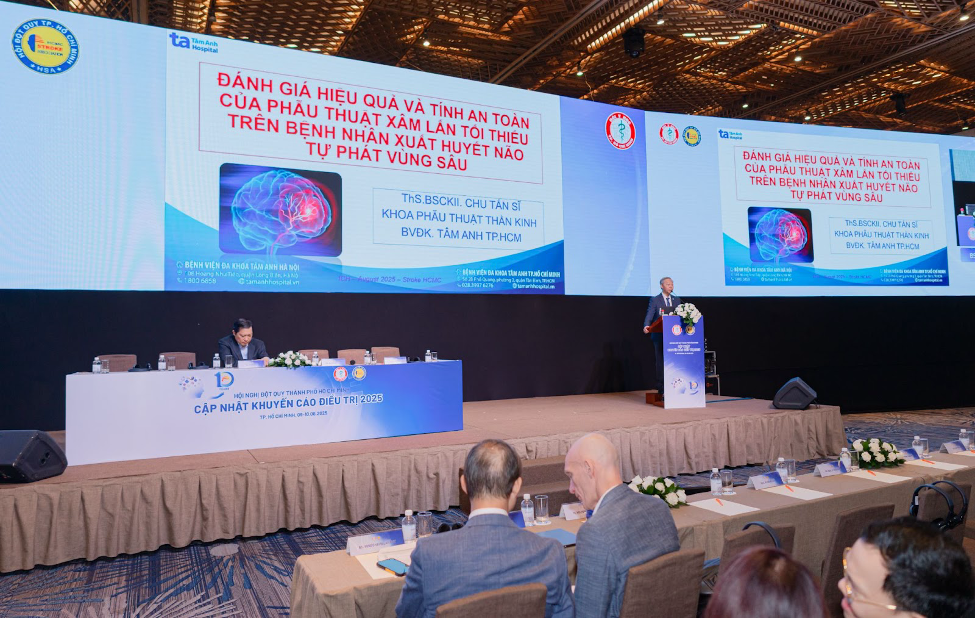This impressive recovery rate is an initial finding from a study conducted by Dr. Chu Tan Si, Head of Neurosurgery at Tam Anh General Hospital in Ho Chi Minh City. The study, presented at the Stroke Conference on 10/8, focuses on patients who underwent MIS for intracerebral hemorrhage within 30 days of the procedure. The ongoing three-year study (2025-2027), involving over 300 patients and multiple stroke centers, is the first large-scale investigation in Vietnam to evaluate the effectiveness of MIS for spontaneous deep brain hemorrhages. This condition is typically difficult to treat and carries a poor prognosis.
The study divided patients into groups based on the timing of surgical intervention (within the first 24 hours and between 24 and 72 hours) and compared them to a group receiving conservative medical treatment. Researchers tracked mortality rates, motor and neurological recovery, National Institutes of Health Stroke Scale (NIHSS) scores, and modified Rankin Scale (mRS) scores, which assess disability and independence after a stroke. After 30 days, no deaths or severe functional decline were reported in the MIS group. Notably, 97% achieved a neurological deficit score below one, indicating minimal residual effects. Many patients regained near-normal motor and communication skills within days of the procedure.
"Preliminary results suggest MIS can shorten the critical intervention window for deep brain hemorrhages, reduce mortality, and improve quality of life for patients with a severe prognosis," Dr. Si stated. He added that the 30-day mark is an early benchmark for assessing post-stroke intervention effectiveness, helping determine initial safety and recovery potential. Longer-term studies (3, 6, and 12 months) are underway to evaluate sustained functional recovery and long-term effects.
 |
Dr. Si presenting at the Ho Chi Minh City Stroke Conference 2025. Photo: Tam Anh General Hospital |
Dr. Si presenting at the Ho Chi Minh City Stroke Conference 2025. Photo: Tam Anh General Hospital
Spontaneous intracerebral hemorrhage, the most dangerous type of stroke, occurs when a blood vessel ruptures within the brain, causing a hematoma that compresses surrounding neural structures. The mortality rate for this type of stroke is typically 30-50% due to delayed or ineffective emergency care. Only 10-25% of survivors regain independent function.
Surgery is crucial for treating intracerebral hemorrhage. Traditional open craniotomy, involving large incisions (10-15 cm), risks damage to healthy tissue and prolongs recovery. MIS, with its smaller incisions (2-5 cm) and targeted approach, minimizes trauma to healthy tissue by utilizing natural brain fissures and avoiding major nerve bundles. This technique has advanced rapidly in Vietnam in recent years, aided by technologies like AI-powered surgical robots, AI-based neuronavigation systems, and BrainPath.
For instance, a 47-year-old male patient, experiencing hemiplegia and altered consciousness, underwent MIS at Tam Anh Hospital, where doctors removed almost the entire deep hematoma. He regained normal mobility within two weeks. A 57-year-old female patient with a putaminal hemorrhage underwent MIS to avoid open craniotomy. She was discharged after 10 days in stable condition.
The Ho Chi Minh City Stroke Conference 2025, attended by over 1,000 delegates, showcased the latest advancements in stroke diagnosis, treatment, and rehabilitation, including personalized therapy, AI applications in diagnostics, specialized training, inter-hospital emergency systems, and international collaboration.
Phuong Thy
| Readers can submit questions about neurological diseases here for doctors to answer. |












